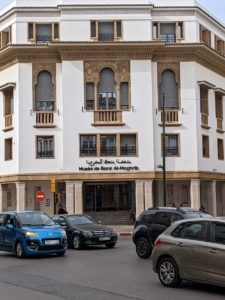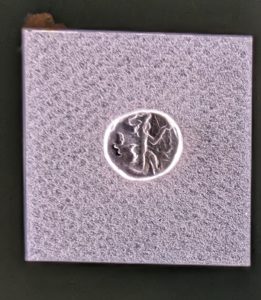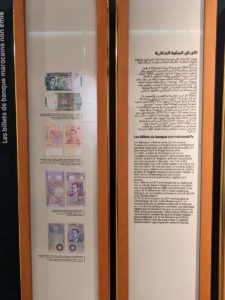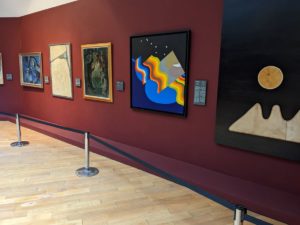 Morocco’s central bank has a museum in Rabat, the nation’s capital, and it is worth a visit. The collection and exhibits are a mix of economic history, numismatics, and works by Moroccan artists. The Bank al-Maghrib Museum also hosts public performances and corporate events. (Maghrib, which means “west” or “sunset”, is the Arabic name for Morocco.)
Morocco’s central bank has a museum in Rabat, the nation’s capital, and it is worth a visit. The collection and exhibits are a mix of economic history, numismatics, and works by Moroccan artists. The Bank al-Maghrib Museum also hosts public performances and corporate events. (Maghrib, which means “west” or “sunset”, is the Arabic name for Morocco.)
The museum is located in a neighborhood with a lot of government offices. The area is pretty busy on a weekday afternoon. Admission is 20 dirham, or about $2.00 US. The box office attendant was at lunch when I arrived, so the security staff let me walk in. The collection is impressive and well worth the admission, so it was even more of a delight for free.
For millennia, Morocco’s economy has been based on trade. The country’s proximity to Europe, its Atlantic and Mediterranean ports, and location along Saharan trade routes ensured that people would come to Morocco to make deals. This means that money and banking are key components of the country’s history. The museum shows off the currencies used in the area, the coins and bills of the Moroccan government since it regained independence in 1956, and has an explanation of central banking. The signage is in Arabic and French. I don’t speak French, but I could parse a lot of the descriptions. (It helps to understand financial terms.)
country’s proximity to Europe, its Atlantic and Mediterranean ports, and location along Saharan trade routes ensured that people would come to Morocco to make deals. This means that money and banking are key components of the country’s history. The museum shows off the currencies used in the area, the coins and bills of the Moroccan government since it regained independence in 1956, and has an explanation of central banking. The signage is in Arabic and French. I don’t speak French, but I could parse a lot of the descriptions. (It helps to understand financial terms.)
 The artwork was a great surprise. I’ve been to a few money museums in my day, being a financial nerd and all, and I haven’t seen one that also had an art gallery. Looking at the works gave me some more appreciation for Morocco’s history and culture. It makes sense, in a way: art is part of a nation’s treasure, so why not show it along with the money?
The artwork was a great surprise. I’ve been to a few money museums in my day, being a financial nerd and all, and I haven’t seen one that also had an art gallery. Looking at the works gave me some more appreciation for Morocco’s history and culture. It makes sense, in a way: art is part of a nation’s treasure, so why not show it along with the money?
This museum isn’t on typical tourist routes, and the guards seemed genuinely happy that I was there. It is totally worth the trip, though. If you find yourself in Rabat for work or for fun, stop by.




